
Banksia purdieana is a species of bushy shrub that is endemic to Western Australia. It has broadly linear, pinnatipartite leaves with sharply-pointed lobes on the sides, yellow flowers in heads of about eighty and egg-shaped follicles.

Eremophila dichroantha, also known as bale-hook eremophila, is a flowering plant in the figwort family, Scrophulariaceae and is endemic to the south-west of Western Australia. It is a shrub with many ascending branches making the plant appear broom-like. It has small, hooked leaves and small, though abundant, violet to lilac-coloured flowers.

Melaleuca cliffortioides is a plant in the myrtle family, Myrtaceae and is endemic to the south-west of Western Australia. It is a small, prickly shrub very similar to Melaleuca podiocarpa but with fewer stamens in the flowers.

Melaleuca psammophila is a plant in the myrtle family, Myrtaceae, and is endemic to the south-west of Western Australia. It is a small shrub with narrow leaves, heads of purple, pink or mauve flowers and clusters of woody fruit. It is similar to M. bisulcata but differs from that species in characters such as the shape of its fruit, leaves and buds but like that species is an attractive, profusely flowering shrub suitable for cultivation as a garden plant.

Melaleuca sclerophylla is a plant in the myrtle family, Myrtaceae, and is endemic to the south-west of Western Australia. It is distinguished by its unusual leaves which are rough, leathery and covered with small, warty lumps and by its many purple heads of flowers in early spring.
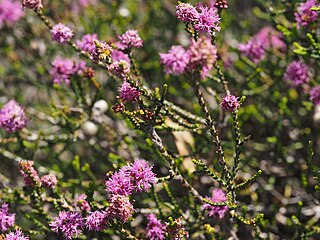
Regelia cymbifolia is a plant in the myrtle family, Myrtaceae and is endemic to the south-west of Western Australia. It is a much branched shrub bearing tiny, wedge shaped leaves and clusters of deep pink to purple flowers on the ends of its branches in spring.

Isopogon alcicornis, commonly known as the elkhorn coneflower, is a plant in the family Proteaceae and is endemic to part of the South Coast Western Australia. It is a low shrub with pinnately-lobed leaves and oval heads of hairy, white or pink flowers.

Eremophila georgei is a flowering plant in the figwort family, Scrophulariaceae and is endemic to Western Australia. It is a common, widespread shrub in central areas of the state, often growing on rocky ridges and hillsides and has serrated leaves and mauve, purple or pink flowers.

Eremophila ionantha is a flowering plant in the figwort family, Scrophulariaceae and is endemic to Western Australia. It is a shrub with many sticky branches, narrow, light green leaves and blue, purple or violet flowers.

Eremophila platythamnos, commonly known as desert foxglove, is a flowering plant in the figwort family, Scrophulariaceae and is endemic to Australia. It is an erect shrub with short, broad leaves and purple, mauve, blue or pink flowers.
Verticordia stenopetala is a flowering plant in the myrtle family, Myrtaceae and is endemic to the south-west of Western Australia. It is a low shrub with small leaves and heads of pink to magenta-coloured flowers in late spring and early summer.

Kunzea montana, commonly known as mountain kunzea, is a flowering plant in the myrtle family, Myrtaceae and is endemic to the south-west of Western Australia. It is a shrub or small tree with more or less round leaves and heads of cream-coloured to pale yellow flowers on the ends of the branches in late spring. It is an uncommon species, growing on rocky mountain slopes, but all populations are conserved in the Stirling Range National Park.
Hibbertia andrewsiana is a species of flowering plant in the family Dilleniaceae and is endemic to the south-west of Western Australia. It is a shrub with an erect or spreading habit and typically grows to a height of 15–60 cm (5.9–23.6 in). It blooms between September and January and produces yellow flowers.
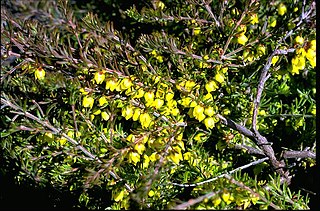
Boronia purdieana is a plant in the citrus family, Rutaceae and is endemic to the south-west of Western Australia. It is a shrub with pinnate leaves and yellow, four-petalled flowers arranged singly in leaf axils.
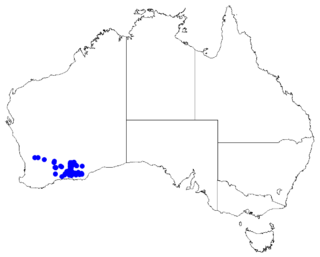
Cyanothamnus fabianoides is a plant in the citrus family, Rutaceae and is endemic to the south-west of Western Australia. It is a compact shrub with many branches, simple, more or less cylindrical leaves and single white, pink or pale blue four-petalled flowers in the leaf axils.
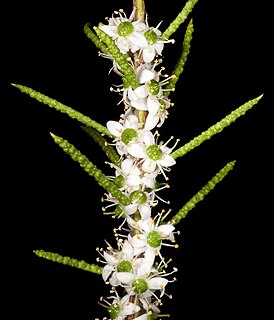
Philotheca deserti is a species of flowering plant in the family Rutaceae and is endemic to inland Western Australia. It is an erect shrub with narrow spindle-shaped, glandular-warty leaves and white flowers arranged singly in leaf axils.

Philotheca tomentella is a species of flowering plant in the family Rutaceae and is endemic to the south-west of Western Australia. It is an undershrub with small club-shaped to cylindrical leaves and white flowers with a pale red central stripe, arranged singly or in groups of up to four on the ends of branchlets.
Goodenia eremophila is a species of flowering plant in the family Goodeniaceae and is endemic to inland areas of Western Australia. It is an ascending herb with linear to elliptic leaves and thyrses of blue flowers.
Hibbertia eatoniae is a shrub in the family Dilleniaceae family and is endemic to the south-west of Western Australia. It is an erect, wiry shrub that typically grows to a height of 15–60 cm (5.9–23.6 in). It flowers from May to October and produces yellow flowers. It is similar to Hibbertia ancistrophylla but has leaves with short, scale-covered petioles, flowers with peduncles and hairy carpels and to H. lepidocalyx but has smaller leaves. It was first formally described in 1904 by Ludwig Diels in Botanische Jahrbücher für Systematik, Pflanzengeschichte und Pflanzengeographie. The specific epithet (eatoniae) honours Alice Eaton of Youndegin, who collected the type specimens.
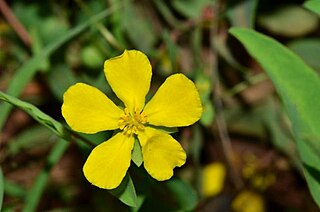
Hibbertia nymphaea is a species of flowering plant in the family Dilleniaceae and is endemic to the south-west of Western Australia. It is a prostrate or straggling shrub that typically grows to a height of 40 cm (16 in) and flowers between August and October producing yellow flowers. It was first formally described in 1904 by Ludwig Diels in Botanische Jahrbücher für Systematik, Pflanzengeschichte und Pflanzengeographie. The specific epithet (nymphaea) is a reference to nymphs who live in fountains and rivers.
















